Text

Not far from the coast of what once was the country of Lebanon two giants of the marsh encounter each other. These two behemoths are part of two different lineages that wouldn’t usually meet. The first one is a ratalac (Myochoerus caviomimus), part of a line of nutria descendants that evolved in Europe around the Mediterranean basin, and they can get to around 1,5 tonnes. The second one’s the dembouc (Tragodus augenos), it’s not much smaller and it evolved from indochinese hippo-like chevrotains that moved into India, since it was without large semi-aquatic herbivores, and later reached West Asia in the early Catiocene through wetter corridors on the coasts and south of the Himalayas and Kashmir.
This area, along with the Black sea’s coast is one of the only places where these two hippo mimics meet. They’re both as aggressive and territorial as their Holocene analogues, rarely allowing animals that could pose a threat to them or their offspring, and actively targeting (especially in the case of ratalacs) the few predators that dare to venture in their territory, mobbing and outright trying to kill them.
These two individuals are both aware of their opponent’s strength and will most likely try to intimidate the other or choose to back away, with neither status, offspring nor food being at stake. They often just tolerate each other’s presence, although still at a safe distance.
In the few areas where they coexist they partition by feeding on different types of vegetation, with ratalacs mostly feeding on plants growing under the water line, and demboucs preferring those above it, sometimes even browsing on reeds
#spec evo#spec bio#speculative evolution#speculative biology#worldbuilding#artwork#digital art#epigene period#future earth#future evolution
16 notes
·
View notes
Text
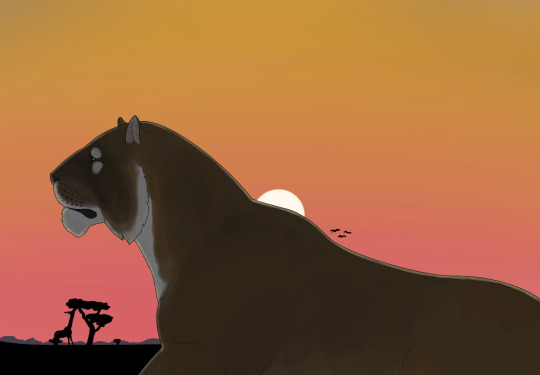
The sun is rising on the savannah. An old cat is resting amidst the grassland. He looks at the territory he held for almost six years at this point, much longer than almost any other male of his species. He’s a Machel’s lion (Leorex macheli), the apex predator of Aethiopia.
This new continent split from mainland Africa just before the interchange and was thus unaffected by it, with many lineages declining or extinct in Afrolaurasia still thriving here, east of the Great Rift Valley and the African Great Lakes.
Moving eastwards and exposed to the currents of the newly formed sea this continent’s climate is slowly but steadily changing. With the Asian monsoons now finally reaching the Eastern coast the first coastal forests are popping up on the edges of the Horn of Africa’s desert, and thanks to the rains brought from the West and strengthened by the equatorial currents the Lake Victoria rainforest was able to expand.

This rainforest is one of the most biodiverse areas of Earth, being so small in size but still hosting so many species. It’s inhabited by a wide array of wildlife. The largest are the ground dwelling primates, the pomorangs (Kampalapithecus chimpiskii), and the many forests antelopes of the genus Relictotragus, or kasolyas.; reptiles and birds alike inhabit the forest, with the most notable ones being pythons, water monitors, parrots and the junglefowl introduced in the Holocene; and a lineage extinct in the rest of the world is still found here, the Smutsiinae, with the still thriving East African giant pangolin (Catiosmutsia aethiopica).
The savannah doesn’t differ much from that of the Anectyocene, with cats, antelopes, dogs, perdvarks and gouebeervarks still being the most common sight there. The main difference here is the evolution of the tomeutheriid, and thus hyracoid, Zoshkoko (Tomeutherium ingens), the largest land animal of the continent, reaching 4 metres in height and rivaling the Pleistocene straight tusked elephant at around 14 tons in weight.
In the last million years there has also been a remarkable case of convergent evolution, with a population of laangvos adapting to a more frugivorous diet and establishing a symbiotic relationship with the Kei apple, eventually evolving into the shaggy wolf (Phytocyon keiophilus), uncannily similar to the maned wolves of South America.

#spec evo#spec bio#speculative evolution#speculative biology#worldbuilding#artwork#digital art#epigene period#future earth#future evolution
8 notes
·
View notes
Text
Despite the general cooling of the planet one particular continent is starting to warm up, allowing a more varied climate better suited for both plant and animal life.
Antarctica has been fully covered in ice for the last 30 million years, but now thanks to its movement northwards and the formation of the Magellan islands between the Antarctic Peninsula and Tierra del Fuego the flow of the Antarctic Circumpolar Current has been broken, allowing warm currents to go along the Pacific coast.
The dominant biome here is tundra and cold prairies, broken by rivers and wetlands.

The largest animals here are all birds. The most common herbivores are flightless ducks and other anseriforms, that get preyed upon by large, but still well adapted for flight, terrestrial birds. These peregrine falcon descendants (Gyrornis ambulans) have developed a hunting strategy much different from that of its ancestor, now basically pouncing on their prey, aided by their wings, and crushing their windpipes with a bite to the neck, in a similar fashion to cats. Although specialised for larger prey they’re also able to take smaller game, allowing it to spread into South America where it feeds on small rodents, youngs of bigger animals and birds.

An unlikely inhabitant of these grasslands is a flightless bird, similar to an upright kiwi that feeds on insects and eggs. Unlike any other bird in the area, its posture, almost plantigrade feet and flattened wings show his ancestry. It’s a penguit (Erectopteryx palmeri), a descendant of small penguins that exploited the new Antarctic environments early on, becoming a quite successful generalist.

The richest ecosystem on the continent are the cold wetlands brought forth by the melting glaciers. These immense areas are a biodiversity hotspot where a myriad of aquatic and semiaquatic species live. At the base of the food chain there’s many freshwater fish lineages, in this case cichlids, trouts and salmons, and semiaquatic insects, like dragonflies and mayflies, that got here from South America. The biggest river predator is the garlachea (Garlachea antarctica), a large salmonid similar to the Amazonian arapaima or to sturgeons. It shares the environment with many semiaquatic mammals, like the English otter (Pyrolutra anglolittoralis), many aquatic rodents, and one of the biggest monotremes yet, the giant polar platypus (Neopilopus fluvialis) that bottom feeds and occasionally catches small fish and other vertebrates.
The swarms of insects feed many more animals, attracting flocks of bats and birds, and feeding the ground dwelling flightless bats and semi-terrestrial salmonids.
#spec evo#spec bio#speculative evolution#speculative biology#worldbuilding#artwork#digital art#epigene period#future earth#future evolution
13 notes
·
View notes
Text
On the coast of the Bay of Bengal a pair of relatively large corvids is walking by looking for food. It’s their first year together and she hasn’t yet laid any eggs, so they can still forage together without worrying about their chicks.

These two birds are sea crows (Thalattocorvus albocephalus), opportunistic omnivores like their ancestors, although showing traits for a seagoing lifestyle: webbed feet, a long and slender bill, hydrophobic feathers and salt glands. They evolved over the course of the last ten million years in response to the shrinking jungle and retreating coastline, caused by the northward movement of the Indian plate. They now thrive in this newly formed shallow sea, scavenging on the coast, diving for fish and occasionally foraging in the forests. Some populations were even able to establish themselves outside of the Sea of Bengal, reaching as far West as Arabia and the Horn of Africa, and as far South as Sumatra.

Going back to our protagonists, the couple has just spotted some nesting lutters, earless phutrids, coming back from their hunt with small fish for their pups. Although usually wary of animals this big, the food brought by these mothers presents a great opportunity for the two. After choosing their targets they set their simple but clever plan in motion. While one of them distracts her the other catches an anchovy and both fly away.
Showing a great degree of adaptability, intelligence and ability to strategise these corvids will be able to establish themselves as some of the most successful birds in the seas of the Epigene and eventually some of the most common.
#spec evo#spec bio#speculative evolution#speculative biology#worldbuilding#artwork#digital art#epigene period#future earth#future evolution
22 notes
·
View notes
Note
What is the biggest / most extensive speculative evolution project that you know of?
Probably Serina. You probably already know of it since it’s one of the most famous spec evo projects out there, but in case you don’t it’s a seedworld with canaries as the only land vertebrates. It’s been going on for almost ten years at this point and covers a 300 million years timespan.
It’s been criticised extensively for I think for the wrong reasons. Most of the weirdest clade are derived enough to be plausible, and my only issue with it are the instances of outcompetition, which doesn’t occur too often on Earth (with most of the real world examples being more likely caused by climate change or other external factors).
Here’s the link if you wanna check it out https://sites.google.com/site/worldofserina/home
Another project that goes quite in depth with its topic is the Yaetuan sagas. I don’t know too much about it, but it should mostly cover the main species’s evolution and development. There’s a book about it and Curious Archives even made a video about it.
Here’s the link for that video along with the link for Curious Archives’ video on Serina
youtube
youtube
Another quite extensive one is Jurassic impact. Not as famous as the previous ones but still well researched and enjoyable. It’s about an alternative Earth where the Chicxulub asteroid hit Earth at the end of the Jurassic. Small dinos, early birds, anurognathids and some mammal clades survived along with crocodylomorphs, choristoderes, and pliosaurs among the others.
Here’s the link to the first post https://www.reddit.com/r/SpeculativeEvolution/s/xT9y0XnxIz
23 notes
·
View notes
Text
Following their prey into new lands the many carnivorous classes that developed over the course of the earliest Epigene came in contact with each other. Unlike the herbivores these predators weren’t as able to partition and suffered greater losses with the Eurasian biota dominating on the African and North American ones in almost every niche.

The small and medium sized forest-dwelling badgers, other musteloids and cats were mostly unaffected, with only the more lynx like terrestrial Bizofelini native of North America declining in diversity. The exchange was catastrophic for African cats tho, with only small extremophilic desert cats surviving along with the last mainland Celerailurine surviving in modern day South Africa and Namibia, Kalailurus mandelae.

Fellimines and Arctofelines displaced all of the large African and North American hypercarnivores that didn’t inhabit rainforest habitats, as golden jackals descendants did with most other larger canids, and Arctochoeropsines with most bigger generalists, except for some more arboreal medium-sized Diacyonines surviving in the Eastern forests of North America.

The only major exceptions to the Eurasian dominance would be the Lycornithines, becoming quite common across the Eurasian and North American grasslands, taking on a similar role to the African secretary birds and South American seriemas; and the Lycothoines, mesocarnivorous pack hunters capable of crushing bone and taking down prey as large as the juvenile Elepharrhinids and even fully grown giant hyraxes, that had no equivalents in Eurasia and North America and thus were able to get into a new niche for those ecosystems.
#spec evo#spec bio#speculative evolution#speculative biology#worldbuilding#artwork#digital art#epigene period#future earth#future evolution
23 notes
·
View notes
Text
While herbivores diversified in the new Afro-Laurasian environment, generalists of all sizes, thanks to the very nature of their lifestyle, thrived almost undisturbed and were able to greatly expand their ranges.

Basal pigs, badgers and rodents all benefited from the interchange, but a new group, part of a lineage of smaller more basal elagids, the squealing heers (Eobrachylagus), in response to the new pressures expanded their diet and became more omnivorous, exploiting various feeding strategies such as scavenging, oophagy and insectivory, and becoming an extremely common animal across the continent, especially common around the tropical and subtropical areas.

Monkeys were mostly unaffected by the event, mostly inhabiting areas far from its contact points. Other than some baboons and other semiterrestrial cercopithecids reaching the northern coasts of the Mediterranean, the only lineage of primates that crossed into another continent was a descendant of Japanese macaques. Its ancestors island hopped to the mainland shortly before the interchange, and thanks to their adaptations to colder environments were able to quickly colonise the coasts of Siberia, and with the closing of the Bering strait to cross into North America. They didn’t radiate into many forms and are currently represented by a single species part of a monotypic genus, the Rockies snow monkey (Smithopithecus montanus). They inhabit a range that goes from Yukon to the rockies, and thus rarely interact with other native North American primate species, although young individuals sometimes come down to the prairies in search of better foraging grounds, where they’re confronted by the hostile macaca baboons (most Cyonuropithecini).

Weird specialists, such as the myrmecophages, were also affected by the interchange. The only major lineages present across the continents are African pangolins, spiny anteaters (hedgehogs that were able to become the dominant myrmecophages in Eurasia thanks to the extinction of the Asian pangolins), and tamanduas that rarely cross into the grasslands and steppe of North America. The latter were hardly affected, spiny anteaters, instead, thrived, with a range going from Florida to the Cape of Good Hope, at the expense, tho, of pangolins, whose only survivors were small arboreal forms in the Congo rainforest.
#spec evo#spec bio#speculative evolution#speculative biology#worldbuilding#artwork#digital art#epigene period#future earth
16 notes
·
View notes
Text
The start of the Catiocene is marked by the closing of the strait of Gibraltar, ending Africa’s period of isolation, shortly followed by the reformation of Beringia, thus allowing the North American and African biotas to come in contact with the Eurasian one, setting the stage for the Great Afro-Laurasian biotic interchange.
Although this event will bring forth the extinction of numerous taxa it definitely won’t be as devastating as the one between the Americas, considering that both North America and Africa by this point will have only been isolated for around 10-15 million years, and that the points of contact will be in environments not as luscious as the Central America forests, nominally the mountainous and arid areas of southern Iberia and western Maghreb, and the Siberian and Alaskan tundra and taiga.
The first pioneers in this case will be the herbivores. Looking for new foraging areas they’ll start to enter the new areas they now have access to, bringing them to competition with their analogues.

In the grasslands heers (Elagidae) are the most common grazers, remaining dominant across Eurasia and outcompeting the grazing jackalopes (Lepolopidae) in North America. Although some were able to establish themselves in Africa, the continent remains a stronghold for the antelopes (Antilopidae and Nesotragidae), that were even able to carve out quite a few niches for themselves across Eurasia and even in Alaska and British Columbia.

Browsing jackalopes, tho, survived and became one of the most widespread herbivores, reaching as far West as Italy and Algeria, and ranging from rainforest environments to arid shrublands. Other common browsers are the scrofeers or holophants (Tetrahyodontinae), a subfamily of Elepharrhinidae mostly present in open woodlands or savannah like environments. Their closest relatives, the cetorcs (Brachyopodinae), are mostly forest and woodland dwellers, where they mostly feed on grass and other kinds of low vegetation, since the big browser niche there is occupied by the massive ground porcupines (Echinotheriidae).

Some other big herbivores are the giant hyraxes (Tomeutheriidae), found across Africa and Eurasia both in forests and grasslands, the serecones (Mayarrhinidae), hardy forest generalists with a range extending at most into China (where they’ve displaced the native Cerolagini, the most basal tribe of heers that has heavily declined continent-wide since the interchange), and the urupines (Moschystricidae), ranging from North Africa to California, but due to the arrival of the antelopes now mostly restricted to forest habitats.
#spec evo#spec bio#speculative evolution#speculative biology#worldbuilding#artwork#digital art#epigene period#future earth
8 notes
·
View notes
Text
Two of the biggest islands on our planet have had their fair share of challenges during their transition from the Anthropocene to the Anectyocene, dealing with extinctions, invasive species and loss of diversity.

One of them, New Zealand, at our time ravaged by invasive cats, stoats, deers and mice, has now managed to go through it. While now having a much more mammal-heavy biota, with the invasive species having adapted similar forms to their continental relatives, the birds were still able to remain important players in these ecosystems, both as small generalists and scavengers, like the ever present kiwis, and as large specialists, like the Southern Rakaumanu, the biggest land animal on the island, that roams the inland and eastern grasslands of South Island.
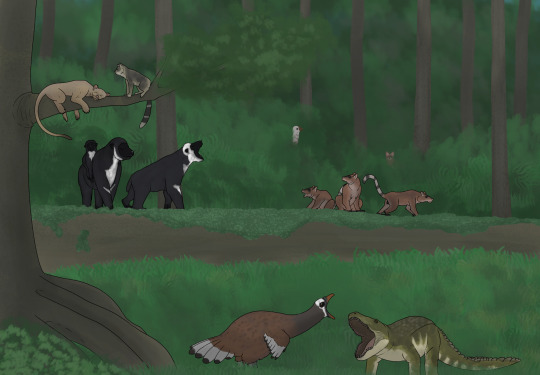
The other island, Madagascar, suffered much less the damages of the invasive fauna, with only lemurs suffering the heaviest losses. Currently the invasive cats and dogs have been able to only take over similar niches to their Holocene ones, remaining small tree hunters and medium-sized pack hunters and scavengers. The abscence of a bigger tree dwelling hunter allowed the fossa to not lose its niche and get outcompeted, but it won’t be able to become the true Malagasy apex predator as crocodiles would get there first.
Lemurs will reclaim much of their former diversity, even adapting similar forms to the African and South American simians, with land dwelling browsers and semi-terrestrial almost baboon-like generalists. The largest herbivores there, tho, would become geese and ducks, that would become flightless and the most prolific herbivores on the island.
#speculative evolution#speculative biology#spec evo#spec bio#worldbuilding#artwork#digital art#epigene period#future earth
23 notes
·
View notes
Text
After the Anthropocene mass extinction Africa’s movement made it break off Eurasia and let it develop its own fauna without competition from the neighbouring landmass.
Other than the many carnivorans, like Sankara’s cat or the broad-faced dogs, many other critters inhabit the continent, both herbivores and omnivorous generalists.
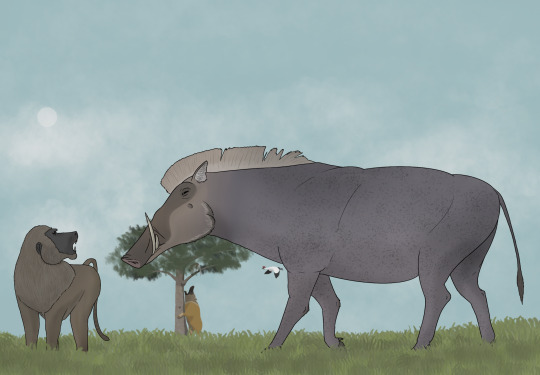

Quite a common sight in the Anectyocene savannah are surely the Perdvarks (Hippochoerus longipes), long legged cursorial warthogs that roam the flat landscape in droves of sows and piglets or bachelor males, or alone, in the case of older boars. Another swine, the bushpig, took a different route, keeping their omnivorous diet and growing bulkier, letting a lineage of big omnivores evolve, containing the biggest predator in the African continent, the Gouebeervark (Hyodus inexpetans), capable of taking down, albeit rarely and with difficulty, the enormous hyraxes that inhabit the grasslands and forests.

A quite successful group are definitely the monkeys, whose diversity didn’t even drop too much, losing “only” the great apes, most baboons, geladas, mandrills, drills and some smaller ones. They’ll prosper in this epoch, with their numbers skyrocketing both in the rainforest and the savannah, and with many adapting new forms, such as some blue monkeys converging on a gorilla or ground sloth bodyplan.

The most successful group across the continent, tho, are definitely the antelopes, descended from the smaller species such as dik-diks and grysboks. They are found anywhere in Africa, in every ecosystem, where they’ve replaced all of their bigger extinct relatives, becoming graviportal herbivores, high browsers and cursorial grazers, and now dominate the landscape as their cousins did before them.
#spec evo#spec bio#speculative evolution#speculative biology#worldbuilding#artwork#digital art#epigene period#future earth
24 notes
·
View notes
Text
Being the crossroad between Eurasia and Australasia south-east Asia has always been quite biodiverse, with environments quite different from each other and with many endemic species.


India and South China have the most similar biomes to the rest of Eurasia, with the deer or antelope like Elagids and the heavily-built Moschystricids being some of the most common sights in both the grasslands and the forests of these two regions, along with the enormous Elepharrhinids, and the many cats and dogs that radiated into many different forms, from the almost bear like Arctofelis indicus and the big Fellimus chenxiaoxi to the smaller Pernicofelis namadicus and wolf-like Thoocyon sinensis. Unlike the rest of the continent, tho, this area is home to some of the largest birds of their time, descended from hornbills that became flightless and are now quite successful grazers and browsers.

The indochinese peninsula is one of the most important biodiversity hotspots. Other than the many cats, dogs and hog bears, that are widespread across the continent but here have their greatest numbers, both in species and individuals, this is one of the only places in Eurasia where nutria descendants, more used to temperate climates, aren’t the biggest semi-aquatic herbivores, which are instead descended from chevrotains. They graze on the river bed and browse on the reeds that grow on the riverbanks, and are quite territorial, fighting each other with their fangs to impose dominance.
This is also the only mainland region where apes are still alive, with many gibbon species thriving in the rainforest.

On the border between Asia and Oceania, the island of Papua is one of the only places where the biggest animals aren’t mammals, but birds and crocodiles, that occupy the niches of big herbivores and carnivores. The biggest mammal on the island is the Greater tree kangaroo (Simiolagus grandis), around the side of a small chimp. This island is also the refugium of the last big ratite, the dwarf cassowary, whose only relatives are the still basal tinamous in South America and the New Zealand kiwis.
If you want to join the discord project’s discord server here’s the link https://discord.gg/5TqDEFb7
#spec evo#spec bio#speculative evolution#speculative biology#worldbuilding#artwork#digital art#epigene period#future earth
15 notes
·
View notes
Text
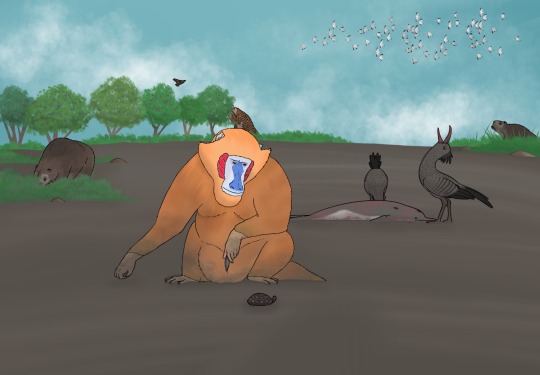
In the Anectyocene North America is one of the most biodiverse continents, thanks to the extreme variety of biomes, and having a biosphere much more different than the rest of the world. Its ten million years isolation from Afro-Eurasia, and partial isolation from South America, thanks to both mountains and the rainforest not allowing bigger pampas and chaco dwellers to reach the northern continent, allowed it to develop much more distinct ecosystems.

One of the most diverse and common clades in the continent are Lepolopidae, walking or running jackrabbits inhabiting both the grasslands, the redwood forests in the west and the humid forests in the east, that diverge in many ways from their Eurasian cousins.
They’ve developed antlers instead of tusks (or horns in some cases), and evolved their outermost toes into opposable and semi-opposable digits, allowing them to become quite skilled climbers, letting them browse on trees regardless of their height, and helping them escape from land dwelling predators.
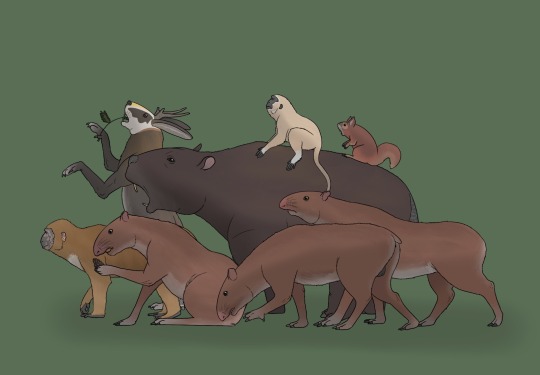
Another quite diverse group of herbivores are the Mayarrhinidae, agouti descendants that came from Central America and expanded into the rest of the continent, that consume almost every kind of plant matter and are quite important seed dispersers of evergreens and oak-trees.
The most important seed dispersers of the continent, tho, are monkeys, especially macaques, whose expansion northwards allowed the expansion of many plants descended from feral fruit producing species.
North American monkeys are all descended from four ancestral introduced species: squirrel monkeys, capuchins, crab eating macaques and rhesus macaques. The first two are for the most part limited to Florida, and on a lesser degree the denser parts of the southern US’ forests, while the two macaques have an almost continent-wide range, going from British Columbia to Sinaloa, and from California to Newfoundland. Thanks to the absence of primates in these areas these macaques have been able to undergo an adaptive radiation, giving life to the polyphyletic group of the New World macaques (Bibliopithecinae, for the rhesus descendants, and Galactopithecinae, for the crab-eater descendants), and resulting in a myriad of forms resembling baboons, geladas, tamarins (that in some cases even compete with squirrels) and apes.
Many changed diets, becoming grazers, leaf eaters and in one case molluscivorous. The Cyonuropithecus caelurorrhinus is a Galactopithecine part of a gelada like genus inhabiting the areas of the Atlantic coast of Canada and the Northern US. Although the other members of its genus are for the most part grazers their diet is mainly made up of molluscs and crabs that they found on the shore with low tide. For this lifestyle they evolved naked hands and wrists and a stronger bite force. They’re also some of the best primate swimmers, thanks to their partially webbed hands.
Some of the biggest herbivores of the continent evolved from beavers, the biggest surviving rodents, that would become as big as hippos and rhinos, and would graze on the bushes and grasses on the ground. The actual biggest land animals, tho, are the ground porcupines, that came from South America, and being generally good rainforest dwellers were able to pass through Central America with ease.
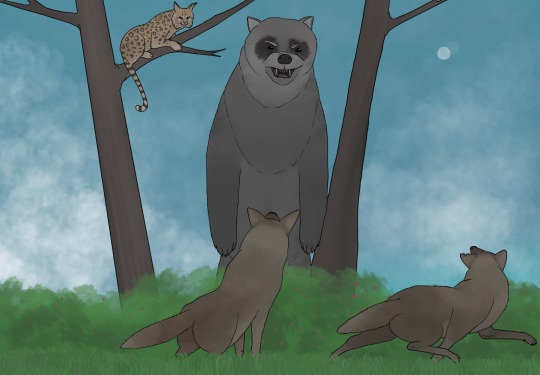
The predators of North America, though, are what really set it apart from the rest of the world, being the only continent, not counting islands like Madagascar, without a mammalian apex predators. Like South America during most of the Cenozoic the continent’s hypercarnivores are birds, more specifically caracara descendants, whose only competitors are the Diacyonines, bear-like raccoon descendants with an omnivorous diet. The other main predatory clades of the continent are the Latrantocyonines, wolf analogues descended from coyotes, and partially from dogs too, the Lycornithines, roadrunners that mainly scavenge and hunt small game, and Bizofelines, descendants of domestic cats that are now arboreal lynx like hunters, and effective mountain dwellers too.
https://discord.gg/KjusGndh discord link if u wanna join the project’s server
#spec evo#spec bio#speculative evolution#speculative biology#artwork#worldbuilding#digital art#epigene period#future earth
15 notes
·
View notes
Text
ftr I am forever going to be bitter that the post I wanted to be "let's talk about extinct ecosystems and how cool they are!" got derailed into yet another post just talking about a single taxon like the millions of other posts on palaeoblr
19K notes
·
View notes
Text
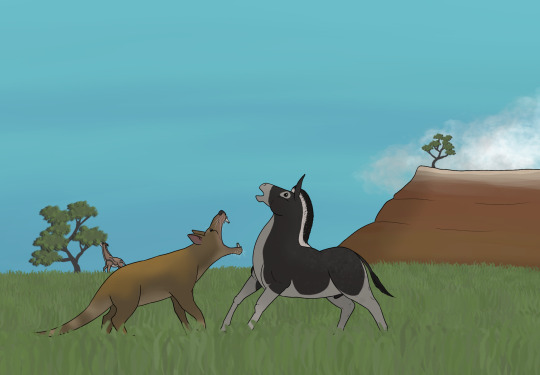
As of now Australia is the fastest moving continent of the planet, going northwards at around 9 cm a year. This rapid movement allowed the Australian ecosystems to shift, thanks also to a wetter and hotter climate.
The dry outback will be greatly reduced, with the shrubland now relegated to just the southwest and the Gibson desert, now replaced by the wetter savannah, while the north and the northeast will be covered in monsoon forests and rainforests, similar to those in Papua New Guinea.
This new landscape will result in a much more varied and diverse landscape, comparable to Africa.
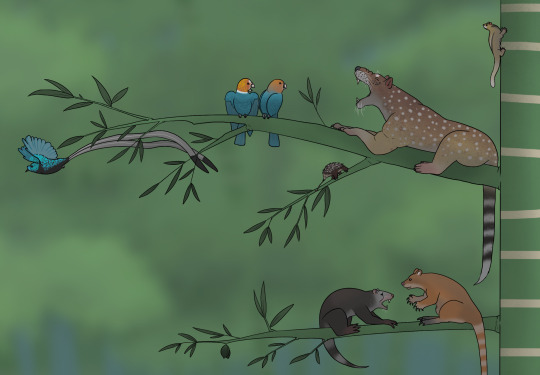
Like in rest of the world the main rainforest trees are bamboo, while dry forests are mostly eucalyptus. On and around these trees lives a great variety of life, including tree-kangaroos, folivorous and frugivorous parrots, birds-of-paradise, echidnas, possums and gliders. The higher trophic levels are occupied by Dasyuromorphs, such as the Leopard quoll (Cyrtonyx pardus), the apex predator of the continent’s forests, and the raccoon like Queensland devil (Bambusarcotherium queenslandi), one of the smallest member of an extremely successful lineage descended from Tasmanian devils reintroduced to the mainland.

Other sarcophilids include the bear-like semiarboreal great glutton (Thylacarctos galactostethus), who’s also the Queensland devil’s closest relative, the pouch hound (Tachythylacoides macropodarium), a specialised cursorial predator that reaches speeds higher than a greyhound, the toothy badger (Hyaenomeles cynicus), a medium sized scavenger and occasional hunter, and the savannah’s apex predator, the sabertooth demon (Thylacobellator deinodon), that wrestles its prey to the ground and rips its throat out.
This predator diversity, similar to that of Africa, is only possible thanks to the great diversity in herbivores, who mostly come from three different lineages: macropods, wombats and, surprisingly, donkeys, being the last surviving perissodactyls of our world.

Although in the Pleistocene there were browsing walking kangaroos, in this epoch their niche will be taken by donkeys, some of whom will come to resemble modern day giraffes, tho most of them will remain fairly similar to their ancestors.
Among them there’s also the first hippo analogue of the continent: the Aussie kelpie or water horse.
Wombats will take the route of their extinct relatives, becoming heavy grazers, while macropods will mostly remain as they are right now, except for some derived wallaroos (the tapiroos), that became faster, to better run from the pouch hounds, shortened their arms, in a similar fashion to abelisaurids, and developed a trunk, in order to cope with their arms, now unable to help them in foraging.
#spec evo#spec bio#speculative evolution#speculative biology#digital art#artwork#worldbuilding#epigene period#future earth
34 notes
·
View notes
Note
Will you show us what life is like on North America anytime soon
Yeah it’s either gonna be the post after the next one or the one after that.
It’s gonna be quite a unique environment, since Beringia doesn’t exist yet and the rainforest acts as a block to bigger South American animals, with different animals at the top of the food chain, and ecosystems in some ways resembling Pleistocene South America.
2 notes
·
View notes
Text

The open oceans of the future would vastly resemble those of today, with similar groups dominating the seas. The biggest and most dominant animals are the cetaceans, descended from two single surviving species: the Commerson’s dolphin and the Guyana dolphin.
Some of the biggest dolphins are the macropredatory Cetovenatoridae, and some enormous bottom feeders, like the muckwhale. Other effective predators are the deep hunting tribune whales, the pod hunting spotted seadogs, and the school targeting Atlantic blue dolphins.
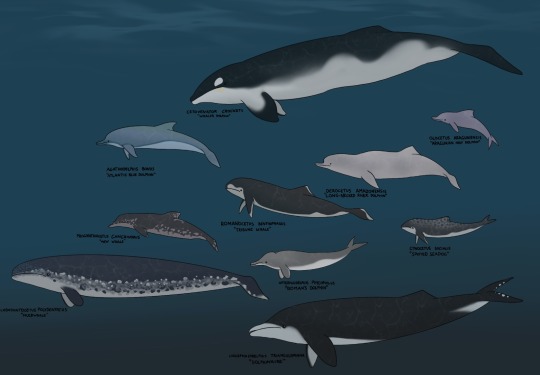
Since seals and other pinnipeds went completely extinct at the end of the Holocene their niche will be filled by the Phutroidea superfamily ( https://www.reddit.com/r/SpeculativeEvolution/s/ljdSwyAmat ), descended from marine otters.
Pelagic fish niches remained mostly unchanged, with most sharks, rays and teleost taxa surviving the mass extinction.

In the Anectyocene oceans, tho, there’s also new additions: a group of ancestrally oceanic platypuses, with a handful of secundarily freshwater Asian and South Pacific species, that feed on invertebrates on the seafloor; and sea sloths descended from three-toed sloths, converging on Thalassocnus’s lifestyle, pulling themselves across the seafloor grazing seaweed, and becoming the biggest sloths since the Quaternary.
#spec evo#spec bio#speculative evolution#speculative biology#artwork#digital art#epigene period#future earth
25 notes
·
View notes
Text
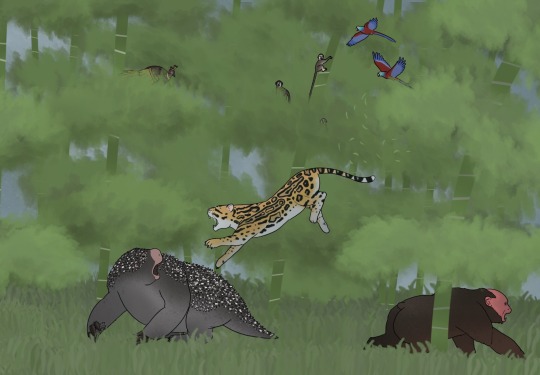
The Amazon, thanks to the warmer climate, and the Central American forests will both be able to expand to the North and South. This greater biome allowed for more diverse ecoregions to appear, boosting the already high Amazon biodiversity of our time.
This expansion allowed the Amazon’s monkeys to reach drier areas, where such a closed canopy couldn’t exist, and where adaptations for a more terrestrial, or even fully terrestrial lifestyle, became necessary. Here two lineages that took to the ground became quite successful: the Hesperopapioninae, that eventually would become a staple of the savannah and grasslands, and the Calvopithecinae, descendants of the bald uakari, with much shorter tails than their ancestors and more robust in build, which are particularly convergent with apes, like the gorilla like sisimito (Melanopithecus sanguinans).
This more open habitat allowed another group to get to the ground, the tree porcupines. These ground porcupines are some of the biggest animals in the rainforest, getting as big as rhinos. They don’t have quills anymore, replaced by sharp and wide scales that they can erect like quills to harm their attackers, although their main weapons are their massive claws that they also use to reach foliage.
Their main predators are the Jaguarote or onça nebulosa (Notopardus panamericanus), who’s also one of the only two big felines in North America, along with its close relative, the puma like onça rubra (Rubrailurus continentalis). It’s a solitary semi-arboreal hunter whose range often expands into that of other Notopardus species.
Other notable tree-dwellers include descendants of most other extant new world monkey lineages, macaws and other American parrots, and neotenic hoatzins, that are even poorer fliers than their ancestors, almost gliding at this point, that use their claws to climb like chicks.

The rivers surrounded by the forests also have their own rich ecosystems, exploited by an array of semiaquatic mammals. The kings of these waterways are the otters, especially the descendants of the Neotropical otter, who took the giant river otter, who, instead, survived only in the brackish waters of Guyana’s, Venezuela’s and northern Brazil’s deltas, where they now occupy a niche similar to crocodilians, hunting both big fish, dolphin calves, terrestrial animals passing through and occasionally Phutridae species that stumble there.
The biggest animals in the basin are caimans, crocodiles and river dolphins, descended from the Guyana dolphin, one of the only two surviving cetaceans.

The most abundant semiaquatic mammal species in the Amazon river, though, is surely the Amazon opossum, descended from the water opossum, with a watertight pouch and joeys already capable of swimming to the surface shortly before developing fur.
#spec evo#spec bio#speculative evolution#speculative biology#worldbuilding#artwork#digital art#epigene period#future earth#future evolution
12 notes
·
View notes